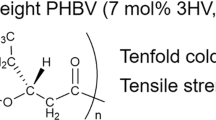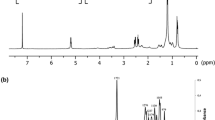Abstract
An efficient process for the preparation of poly(3-hydroxybutyrate) (PHB) microspheres with a narrow size distribution was developed. PHB was produced by a fed-batch culture of Ralstonia eutropha using fructose syrup as the sole carbon source. After autoclaving the bacteria, PHB granules, which accumulated in the cells, were isolated by a detergent/hypochlorite treatment and then spray-dried to obtain the microspheres. The diameters of the PHB microspheres ranged from 0.6 to 1.1 μm and the weight-average molecular weights were approximately 50 000 with polydispersity indexes of 5.0. The microspheres had a porous internal structure with an average porosity value of 72% and efficiently blocked UV light shorter than 220 nm. When isosorbide dinitrate was used as a model drug, the optimal drug loading concentration of the microspheres for controllable retardation was 3% (w/w). Almost 80% of the loaded drug (3%, w/w) was released within 12 h with typical sustained drug release behaviors.
Similar content being viewed by others
References
Amass W, Amass A, Tighe B (1998) A review of biodegradable polymers: use, current developments in the synthesis and characterization of biodegradable polyesters, blends of biodegradable polymers and recent advances in biodegradation studies. Polym. Int. 47: 89–144.
Anderson AJ, Dawes EA (1990) Occurrence, metabolism, metabolic role, and industrial uses of bacterial polyhydroxyalkanoates. Microbiol. Rev. 54: 450–472.
Berger E, Ramsay BA, Ramsay JA, Chavarie C, Braunegg G (1989) PHB recovery by hypochlorite digestion of non-PHB biomass. Biotechnol. Tech. 3: 227–232.
Brannon-Peppas L (1995) Recent advances on the use of biodegradable microparticles and nanoparticles in controlled drug delivery. Int. J. Pharm. 116: 1–9.
Eligio T, Rieumont J, Sanchez R, Silva JFS (1999) Characterization of chemically modified poly(3-hydroxyalkanoates) and their performance as matrix for hormone release. Angew. Makromol. Chem. 270: 69–75.
Gangrade N, Price JC (1991) Poly(hydroxybutyratehydroxyvalerate) microspheres containing progesterone: preparation, morphology and release properties. J. Microencapsul. 8: 185–202.
Kassab ACh, Xu K, Denkbas EB, Dou Y, Zhao S, Piskin E (1997) Rifampicin carrying polyhydroxybutyrate microspheres as potential chemoembolization agent. J. Biomater. Sci. Polymer Edn. 8: 947–961.
Kim DY, Kim YB, Rhee YH (1998) Bacterial poly(3-hydroxyalkanoates) bearing carbon-carbon triple bonds. Macromolecules 31: 4760–4763.
Kim GJ, Yun KY, Bae KS, Rhee YH (1992) Accumulation of copolymers consisting of 3-hydroxybutyrate and 3-ydroxyvalerate by Alcaligenes sp. SH-69 in batch culture. Biotechnol. Lett. 14: 27–32.
Koosha F, Muller RH, Davis SS (1989) Polyhydroxybutyrate as a drug carrier. Crit. Rev. Ther. Drug Carrier Syst. 6: 117–130.
Korsatko VW, Wabnegg B, Tillian HM, Egger G, Pfranger R, Walser V (1984) Poly-D-(-)-3-hydroxybutyric acid-a biodegradable carrier for long term medication dosage. Studies on compatibility of poly-D-(-)-3hydroxybutyric acid implantation tablets in tissue culture and animals. Pharm. Ind. 46: 952–954.
Lafferty RM, Korsatko B, Korsatko VW (1988) Microbial production of poly-β-hydroxybutyric acid. In: Rhem HJ & Reed G, eds. Biotechnology: A Comprehensive Treatise, Special Microbial Processes, Vol. 6b. Weinhheim: VCH Publishers Inc., pp. 135–176.
Lauzier C, Revol JF, Marchessault RH (1992) Topotactic crystallization of isolated poly(β-hydroxybutyrate) granules from Alcaligenes eutrophus. FEMS Microbiol. Rev. 103: 299–310.
Law JH, Slepecky RA (1961) Assay of poly-β-hydroxybutyric acid. J. Bacteriol. 82: 33–36.
Middleberg APJ, Lee SY, Martin J, Williams DRG, Chang HN (1995) Size analysis of poly(3-hydroxybutyric acid) granules produced in recombinant Escherichia coli. Biotechnol. Lett. 17: 205–210.
Pouton CW, Akhtar S (1996) Biosynthetic polyhydroxyalkanoates and their potential in drug delivery. Adv. Drug Delivery Rev. 18: 133–162.
Ramos MA, Gil MH, Schacht E, Matthys G, Mondelaers W, Figueiredo MM (1998) Physical and chemical characterisation of some of silicas and silica derivatives. Powder Technol. 99: 79–85.
Ryu HW, Hahn SK, Chang YK, Chang HN (1997) Production of poly(β-hydroxybutyrate) by high cell density fed-batch culture of Alcaligenes eutrophus with phosphate limitation. Biotechnol. Bioeng. 55: 28–32.
Author information
Authors and Affiliations
Rights and permissions
About this article
Cite this article
Kim, G., Bang, K., Kim, Y. et al. Preparation and characterization of native poly(3-hydroxybutyrate) microspheres from Ralstonia eutropha. Biotechnology Letters 22, 1487–1492 (2000). https://doi.org/10.1023/A:1005637827426
Issue Date:
DOI: https://doi.org/10.1023/A:1005637827426




